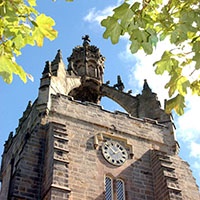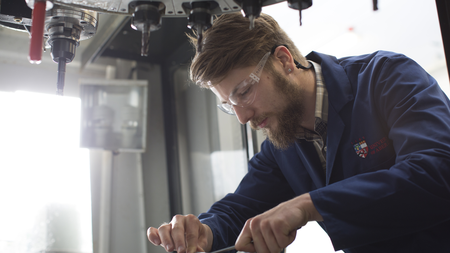
Reader
- About
-
- Email Address
- a.starkey@abdn.ac.uk
- Telephone Number
- +44 (0)1224 272801
- School/Department
- School of Engineering
Biography
Dr Starkey completed his PhD in the application of artificial intelligence techniques to engineering problems from University of Aberdeen in 2001 and attained an Honours degree in Applied Mathematics from St Andrews University in 1993. Since then he has been awarded an Enterprise Fellowship from Royal Society of Edinburgh and Scottish Enterprise, and has a spinout company BlueFlow Ltd that commercialises the AI technology developed.
External Memberships
Dr Andrew Starkey is CEO of a recent spin-out company from the University of Aberdeen, BlueFlow Ltd.
- Research
-
Research Overview
Dr Starkey's main research themes are in the development of Explainable AI, Green AI and Autonomous AI. He has developed a number of novel methods in these themes and also works closely with industry in a range of areas.
Examples of previous research include robotics, econometrics (the study of financial markets), bioinformatics (in particular genomic and proteomic analysis), engineering problems and the analysis of seismic data and the integration of AI and virtual reality.
Research Areas
Accepting PhDs
I am currently accepting PhDs in Engineering.
Please get in touch if you would like to discuss your research ideas further.

Research Specialisms
- Artificial Intelligence
- Knowledge and Information Systems
- Machine Learning
Our research specialisms are based on the Higher Education Classification of Subjects (HECoS) which is HESA open data, published under the Creative Commons Attribution 4.0 International licence.
Current Research
Current research projects:
Developing AI technologies that are explainable (XAI) and low in computational cost (Green AI).
- Development of methods for the automated analysis of relevant features for a problem (Feature selection)
- Development of Autonomous learning for Robotics applications
- Development of techniques to abstract knowledge from an agent's interactions with its environment
- Text analysis, and in particular topic analysis and contextual analysis. Novel techniques developed that can dynamically identify new topics being discussed (or old topics no longer being talked about).
- Multi-label classification engines, using XAI and low computation models
- Development of novel method capable of automatically identifying and describing features of interest for a class, plus best in class predictive capability (XAI, and Green AI).
Past Research
In the past, a major research topic was the Granit project, which involved the application of AI to the condition monitoring of ground anchorages. This project resulted in a number of awards including the Millennium Product Award and the John Logie Baird Award for Innovation.
Funding and Grants
Current projects include:
- Investigating data mining methods applied to econometrics
- In silico identification of functional human cis-regulatory sequence-gene linkage (funded by BBSRC) joint project with Dr Alasdair MacKenzie and Scott Davidson
- a grant from the BBSRC Research Equipment Initiative for a computer rack system to facilitate the computations required for textual bioinformatic approaches
- Analysis of seismic data for automated recognition of geological features, joint project with Dr Anne Schwab
- “Design and assessment of condition of soil anchorages in a dynamic environment using the centrifuge modelling technique” funded by EPSRC, jointly with Drs Ivanovic and Neilson and Prof Rodger and also Prof Davies of University of Dundee
- Investigation into genomic prediction for melatonin action in animals, joint project with Dr David Hazlerigg
- “Pattern recognition approaches to understand replication origin specification”, joint project with Dr Anne Donaldson and Dr Conrad Nieduszynski
- Publications
-
Page 1 of 7 Results 1 to 10 of 66
Response to the Joint Committee on Human Rights (JCHR) Call for Evidence: Human Rights and the Regulation of Artificial Intelligence
University of Aberdeen: School of Law. 13 pages.Other Contributions: Other ContributionsClusterSwarm: cluster-specific feature selection using binary particle swarm optimisation
Computing, vol. 107, 180Contributions to Journals: Articles- [ONLINE] DOI: https://doi.org/10.1007/s00607-025-01534-8
- [ONLINE] View publication in Scopus
Response to UKIPO Consultation on Copyright and Artificial Intelligence
University of Aberdeen: School of Law. 11 pages.Other Contributions: Other ContributionsA Practical Sensor-to-Segment Calibration Method for Upper Limb Inertial Motion Capture in a Clinical Setting
IEEE Journal of Translational Engineering in Health and Medicine, vol. 13, pp. 216-226Contributions to Journals: ArticlesUnsupervised Neural Architecture for Sensorimotor Mapping in Perceptually Aliased Environments
Chapters in Books, Reports and Conference Proceedings: Conference ProceedingsExploring North Sea Fractured Sandstone Properties: Artificial Intelligence, Multiscale Imaging, Pore-Fracture Network Analysis and Experimental Results
Chapters in Books, Reports and Conference Proceedings: Conference Proceedings- [ONLINE] DOI: https://doi.org/10.2118/220049-MS
- [ONLINE] View publication in Scopus
2023 8th International Conference on Robotics and Automation Engineering Quantifying the Performance of Deep Neural Networks in Predicting Curvature and Force Output Response of a Pneumatic Soft Actuator
Chapters in Books, Reports and Conference Proceedings: Conference ProceedingsCan Complexity Measures and Instance Hardness Measures Reflect the Actual Complexity of Microarray Data?
Chapters in Books, Reports and Conference Proceedings: Conference Proceedings- [ONLINE] DOI: https://doi.org/10.1007/978-3-031-53969-5_33
- [ONLINE] View publication in Scopus
Applying Green AI methods to Digital Rock Technology workflows
Granite Journal: The University of Aberdeen Postgraduate Interdisciplinary Journal, vol. 8, no. 1, 5Contributions to Journals: ArticlesOne-Shot Learning for Task-Oriented Grasping
IEEE Robotics and Automation Letters, vol. 8, no. 12, pp. 8232-8238Contributions to Journals: Articles- [ONLINE] DOI: https://doi.org/10.1109/LRA.2023.3326001
- [ONLINE] View publication in Scopus
